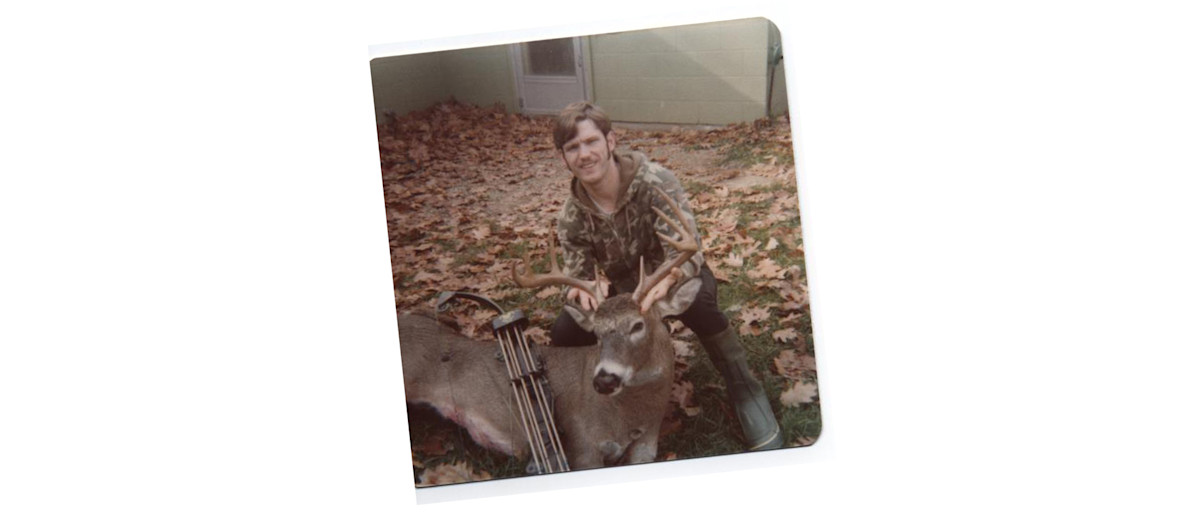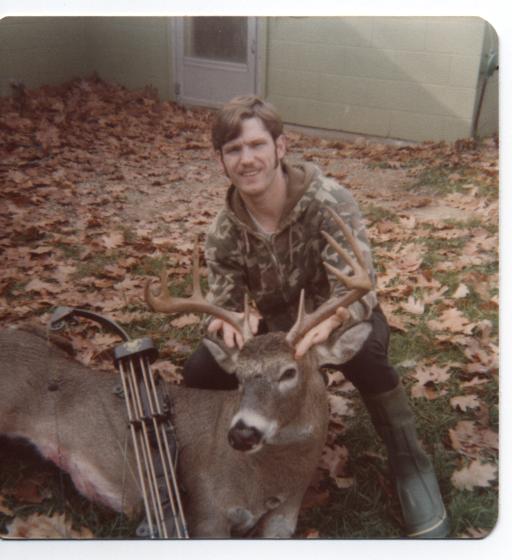
If you enjoyed Episodes #62 and #159 of the Wired To Hunt Podcast with John Eberhart, you’re in for a treat. Over recent weeks, we’ve been sharing a number of John’s successful kill stories and today we’re back with another. John’s detailed description of his hunts and plans offer a rare chance to get into the mind of one of the most seasoned and successful DIY bowhunters in the country. Take this opportunity to really process what he does and why he does it. Enjoy. – MK
By John Eberhart
I can remember this hunt as if it were yesterday because it took place the evening after taking my kids trick or treating in 1978.
A good friend had asked me to help him scout and prepare a location for a big 10 point he had been seeing. I was managing the archery department at Jay’s Sporting Goods at the time and agreed to help him on the condition that he gets permission for me to hunt the property with him.
The Property Layout
This specific piece of property was the largest private parcel and likely the best hunting property in Clare County and even though he only had access to a small portion of it, I really wanted to hunt there. He did manage to land me permission to hunt the last couple days of October, as long as I was with him, as the property owners didn’t allow any bowhunting in November because they were gun hunters and wanted a two week quiet period prior to the November 15th gun opener.
The property consisted of a huge extremely dense swamp with knee to chest high water, scattered brush throughout, small dry humps for deer to bed on and two rather large islands. Just north of the swamp were two large weed fields divided by a ¼ mile wide strip of high ground hardwoods that extended nearly half a mile north from the swamp to an east/west road.
The hardwoods consisted of poplar, beech, maple, birch, and chokecherry, red oak and white oak food bearing trees. There were no crops for miles, so other than browse, at this time of year the deer primarily fed on acorns and chokecherries.
He wasn’t really up to snuff on the differences in bitter tannins between white oak and red oak acorns and had previously gravitated to hunting trees within the hardwoods that simply had the most comfortable crotches to sit in, as back then there wasn’t much in the form of treestands. Hunting trees with adequate and somewhat comfortable crotches meant that luck would play a huge role in him receiving an opportunity at the big 10 point because those types of trees were rarely in the right locations.
On a single scouting venture we set-up a location in the crotch of a huge white oak within 20 yards of a large chokecherry tree. This was a magnificent location that had a rub-lined runway leading to it, several other runways converging at it, white oak acorns and chokecherries which were a primary food source, and a mass of droppings under each tree.
The branches on the trees were too high off the ground to be utilized as licking branches for a scrape, but I believed there would have been scrapes there had the branches had hung lower. While I tried not to show my excitement in front of him, I knew this would be the location the dominant buck would gravitate to once out of the swamp bedding area, there was just too much buck and doe sign for it not to be.
The Set-Up
On the opposite side of the hardwoods from him and much closer to the swamp we set-up a location for me. About 28-feet up a small acorn laden white oak, I nailed a chunk of 2 X 4 in a small crotch to sit on and a 2 X6 in another to put my feet on and stand on. This location had three well-used runways passing by it that were well within my comfortable shooting range.
This location was a good transition area for deer to pass through and munch a few acorns as they headed farther north into the wooded area. On our way out I had him bite into a red oak and a white oak acorn and due to their bitter tannins, he spit the red oak acorn out immediately and actually ate the white oak acorn and knew from then on why deer always prefer whites over reds when it comes to eating acorns.
On his previous hunts he had been seeing deer as early as 3:30pm so on the evening after Halloween we were in our trees by 2:00pm. I remember the date because I was excited about both of our locations and wanted to hunt there the day after we prepped them, but it was Halloween and I did the daddy thing and took the kids trick or treating instead.
The First Hunt
It was a clear sunny afternoon with the temperature hovering around the 45 degree mark when we left the house. He had a spike and some does come in very early and watched as they fed on both chokecherries and acorns beneath around him. This was a tough situation because he had only killed a couple deer with his bow to that point, and under any other circumstances that spike would have had an arrow flung at him.
In the seventies there was no such thing as a whitetail trophy hunter, particularly with archery equipment. Back then passing up on any legal antlered buck with a bow was unheard of and according to DNR surveys, on average only 2% of bowhunter’s took a buck and only 7% took a deer with a bow. Trophies were most frequently by mishap and times have obviously changed as now nearly 30% of bowhunter’s take bucks and if all bowhunter’s targeted any legal antlered buck, that percentage would be much higher. It’s simply a different time.
Depending on how you look at it, his decision to hold off turned out to be a good one as the next deer he saw was the big 10-point. It was the pre-rut and as the buck casually followed the rub-lined runway towards his tree, the other deer fled the scene.
At a distance of only fifteen yards the buck stopped and started feeding on chokecherries. By the time the buck turned broadside to present a shot, my friend was shaking so bad that he had a hard time drawing his bow, not to mention holding his pin on the buck’s chest.
He opened his fingers to release the arrow and watched as it flew over the buck’s back. Without hesitation the buck promptly disappeared back in the direction from which it came. He did get to see that buck one more time, in the back of the property owner’s pick-up on opening morning of gun season.
My first and only deer sighting was at 5:30 and it was a nice 2 ½ year old buck, which at the time was a rarity as well because Michigan had 1,000,000 gun hunters that shot mostly any legal antlered buck, making 2 ½ year olds very rare.
He had come out of the swamp and was browsing along one of the runways that led to my tree. It didn’t take long before he was within 10-yards and broadside. I drew my 60-pound Bear Polar II bow, blatted to stop him, and released the arrow. I also had a small case of the shakes but did manage to hit the buck, but the arrow went in a little farther back than where I had aimed.
He wheeled and headed back into the swamp. I could see my arrow sticking out of the ground and back then you could only take one buck with a bow, so I got down to inspect it. A quick glance confirmed my thoughts about the shot placement. There was brown gritty matter mixed with blood covering the arrow, but there was a descent blood trail. I had likely passed through the liver and stomach.
The Recovery
We met up after dark to exchange stories and although he missed he was very excited, no, he was exhilarated about the opportunity he had. In fact he wouldn’t shut up, so I just stood there grinning about his excitement and listening. After listening for about 5 minutes he finally started to slow down and once he cooled his jets I told him about the buck I had hit.
It was the first time ever that I had been on a hunt where both parties shot at a 2 ½ year old or older buck; that just didn’t happen back then. When he asked how many points mine had, I thought about it for a second, but couldn’t tell him. Interestingly, all I had seen was a good rack, and then tried to concentrate on the shot.
Although there were a ton of coyotes and bobcats in the area, I didn’t want to push the buck deep into the swamp where a recovery would be nearly impossible, so we decided to wait until morning to search for him. Later that night he called and informed me he had to work the next morning as he was a construction worker that worked when called.
The next morning, with another friend to hopefully help drag, we followed the dried up blood trail. It was easy to follow the blood on top of the yellow and brown leaves and even easier through the light beige tall weeds that buffered the woods from the swamp.
We found him dead in a bedded position in some tall weeds just inside the swamp. The beautiful little 8 point had traveled about 200-yards before bedding and eventually expiring. He was facing his backtrack, which confirmed our decision to wait until morning. When I gutted him out, he was still very warm which meant he had survived well into the night.
Lessons Learned
Our hunt definitely aided in the continuation of my learning process. It reaffirmed that concentrating my scouting efforts on destination feeding locations, areas where several runways merge in a transition zone, and holding out for specific locations as opposed to setting up on the first well used sporadic singular sign, was the way to go.
This hunt also reaffirmed my blood trailing practices of being patient and waiting before trailing any questionable hit deer. There is no doubt that 8-point would have been pushed far into the swamp had we trailed him that night, and likely never been recovered. We had weighed the likelihood of coyotes and or bobcats getting to him before daybreak against our odds of him being dead and easily recovered that night, and his warm insides coupled with him being in a bedded position the next morning definitely confirmed we made the right decision.
This information may seem trivial and self-explanatory but back then you had to learn on your own which I personally prefer over all the misinformation in today’s micro-managed property, media driven, mass personal opinion information marketplace.
Editors note: John Eberhart is an accomplished bow-hunter that specializes in heavily pressured areas with 29 bucks listed in CBM’s record book from 19 different properties in 10 different counties. John produced a 3 volume instructional DVD series titled “Bowhunting Pressured Whitetails” and co-authored the books, “Bowhunting Pressured Whitetails”, “Precision Bowhunting”, and “Bowhunting Whitetails the Eberhart Way”. They are available at www.deer-john.net, where you’ll also find information about his new whitetail workshops.






Conversation